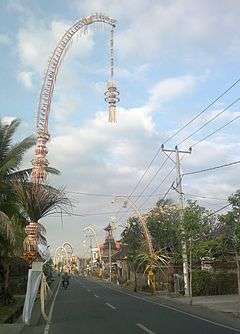Galungan
| Galungan | |
|---|---|
 Penjor lining a road in Bali at Galungan | |
| Also called | Galungan |
| Observed by | Balinese Hinduism |
| Type | Hindus, cultural |
| Observances | Prayers, Religious rituals |
| Date | Decided by the Hindu Balinese pawukon calendar |
| Related to | Diwali (in India), Tihar (in Nepal), Swanti (among Newar in Nepal) |
Galungan is a Balinese holiday celebrating the victory of dharma over adharma.[1] It marks the time when the ancestral spirits visit the Earth. The last day of the celebration is Kuningan, when they return. The date is calculated according to the 210-day Balinese calendar. It is related to Diwali, celebrated by Hindus in other parts of the world, which also celebrates the victory of dharma over adharma.[2][3] Diwali, however, is held at the end of the year.
Significance
Galungan marks the beginning of the most important recurring religious ceremonies. The spirits of deceased relatives who have died and been cremated return to visit their former homes, and the current inhabitants have a responsibility to be hospitable through prayers and offerings. The most obvious sign of the celebrations are the penjor - bamboo poles with offerings suspended at the end. These are installed by the side of roads. A number of days around the Kuningan day have special names, and are marked by the organization of particular activities.[4]
| Name of day | Activities | |
|---|---|---|
| 3 days before | Penyekeban | Cooking of bananas for offerings |
| 2 days before | Penyajaan | Making of jaja (fried rice cakes) |
| 1 day before | Penampahan | Slaughtering of pigs or chicken for feasts |
| 1 day after | Manis Galungan | Visiting family |
| 10 days after | Kuningan | Prayers, offerings - spirits return to heaven |
| 11 days after | Manis Kuningan | Fun |
Dates
Galungan begins on the Wednesday (Buda) of Dunggulan, the 11th week of the 210-day pawukon calendar. This means that there are often two celebrations per solar year. Dates for 2017-2020 are as follows:[5]
| Year | Galungan | Kuningan |
|---|---|---|
| 2017 | April 5 | April 15 |
| 2017 | November 1 | November 11 |
| 2018 | May 30 | June 9 |
| 2018-2019 | December 26 | January 5 |
| 2019 | July 22 | August 3 |
| 2020 | February 19 | February 29 |
| 2020 | September 16 | September 26 |
References
- About.com Southeast Asia TravelSearch Accessed 1 November 2017
- Eiseman, Fred B. Jr, Bali: Sekala and Niskala Volume I: Essays on Religion, Ritual and Art pp 182-185, Periplus Editions, 1989 ISBN 0-945971-03-6
- Pancorbo, Lo balinés", en "Fiestas del Mundo. Las Máscaras de la Luna". pp. 33–41. Ediciones del Serbal, Barcelona, 1996.
Notes
- ↑ Eiseman (1989) p353
- ↑ https://www.buffalotours.com/blog/diwali-festival-lights/
- ↑ https://www.ndtv.com/education/diwali-or-deepawali-2017-10-things-students-should-know-about-the-festival-of-lights-1764533
- ↑ Eiseman (1989) p183
- ↑ About.com
External links
- Video documenting Galungan ceremony preparations on Bali part 1, part2
- How Galungan is celebrated in Bali
